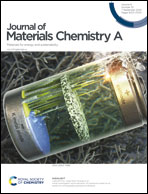Intercalation materials for secondary batteries based on alkali metal exchange: developments and perspectives
Abstract
Chemical and electrochemical alkali metal exchange (AME) techniques are powerful tools to synthesize and investigate active materials for secondary Li-, Na- and K- or mixed-ion batteries. AME can provide fundamental insights regarding the differences of Li-, Na- and K-ion analogue intercalation materials with respect to important battery performance metrics as well as kinetics, thermodynamics, phase transition behavior, etc. For this purpose, the alkali-ions stored inside an intercalation material are (electro)chemically extracted and replaced by another ionic species. This procedure can allow preservation of a desired (metastable) host structure or preparation of mixed ionic species that cannot be obtained by common solid-state or hydrothermal synthesis routes. Herein, recent insights and research trends related to the AME in intercalation hosts for secondary batteries are reviewed. The fundamentals of AME techniques are presented and discussed regarding individual advantages and disadvantages. Recent results obtained from AME are reported for different classes of intercalation materials, particularly polyanionic compounds, layered oxides and spinel oxides. The main differences found for the different crystal structures and promising perspectives related to AME processes are highlighted.



 Please wait while we load your content...
Please wait while we load your content...